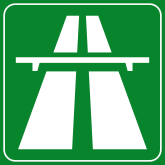Durrës-Kukës Highway
The A1 (Albanian: Autostrada A1 or Autostradë A1), also commonly Rruga e Kombit or SH10,[1] is the longest and only toll motorway in Albania, stretching 114 kilometres (71 mi) in the counties of Lezhë and Kukës.[2] It consists for the most part of two traffic lanes and an emergency lane in each driving direction separated by a central reservation.
| |
|---|---|
| Autostradë A1 | |
| Rruga e Kombit or SH10 | |
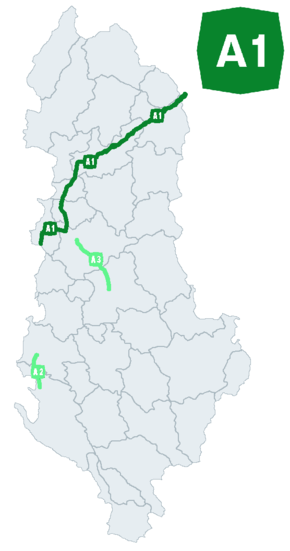 | |
| Route information | |
| Part of | |
| Length | 114 km (71 mi) |
| Major junctions | |
| West end | |
| East end | |
| Location | |
| Counties | Lezhë, Kukës |
| Major cities | Lezhë, Kukës |
| Highway system | |
| Highways in Albania | |
The motorway constitutes part of a larger corridor connecting the Albanian Adriatic Sea Coast in the southeast across the Albanian Alps with the Republic of Kosovo[lower-alpha 1] in the northwest.[3] The significance of the motorway is reflected through its positive economic and cultural impact on the towns and cities within both countries it connects as well as its importance to tourism in Albania.[3][4]
The highway is also commonly known as Autostrada Shqipëri-Kosovë or Autostrada Durrës-Kukës and starts near Lezhë, Albania, passes through Kukës, enters Kosovo as R7, and ends in Pristina near Đurđica, Kosovo. As part of the South-East European Route 7, the highway will connect the Adriatic Sea ports of Durrës and Shëngjin in Albania via Pristina, with the E75/Corridor X near Niš, Serbia.[5] The project was a joint venture by the American-Turkish consortium Bechtel-ENKA, Austrian, Slovenian, and Albanian companies. It is expected to be finalized through a PPP road concession and maintenance project operated by Albanian Highway Concession shpk.[6]
Dubbed the “patriotic highway”, the project links Albanians in Kosovo and Albania, helping to boost cultural and economic ties.[7] The project is Albania's largest in decades, costing over one billion euros. It includes a six kilometer tunnel in Albania, making travel and trade easier for the hundreds of thousands of people vacationing in Albania during summer holidays and for business.
Description
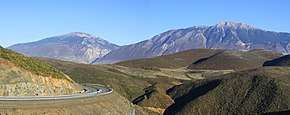
A1 Motorway represents a major northeast–southwest motorway in Albania connecting the Albanian Adriatic Sea Coast in the southwest to the Albanian Alps in the northeast. A significant part of the road network of Albania, it constitutes part of the European route E851 starting at Petrovac in Montenegro across Shkodër and Kukës to Pristina in Kosovo.[8] The planned southwestern part of the motorway around Durrës County is considered to be a segment of the Adriatic–Ionian motorway that will stretch following completion across the Balkan Peninsula from Italy in the north to Greece in the south.[9][10] In Kosovo, the A1 continues as the R7 part of the Pan-European Corridor X.[11]
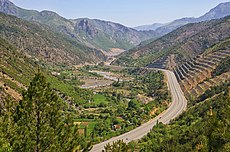
Rruga e Kombit (Nation's Highway) is a toll highway stretching between Milot, Rrëshen, Kalimash, Kukes and the border with Kosovo in Northern Albania part of the Durrës-Kukës Corridor. In June 2009, the highway was opened to traffic with the inauguration of the Thirrë-Kalimash Tunnel, while other sections were partially completed in subsequent years as the highway is still under construction.
Remaining segments between Kolsh, Kukës, and Morinë (border with Kosovo) were part of the SH5 Highway until recently, linking Shkodër and Kukës. However, they became part of A1 as new exits were constructed once the motorway became tolled. The section between Milot and Rrëshen is a single carriageway, while several viaducts near Kukes were only recently expanded into dual carriageways. The Milot Interchange was completed as a Trumpet Interchange in 2019.
The highway has reduced the travel time from six hours to two, with an estimated speed of 80–110 kilometres per hour (50–68 mph). The highway has also boosted tourism in Albania and deepened the cultural and economic exchanges between Albania and Kosovo. As most tourists come through Kosovo, the laying of the highway make it easier to travel to the Durrës and Shengjin ports along the Adriatic Sea.
Rrëshen–Kalimash
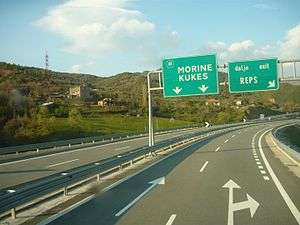
The most challenging part of the corridor was the segment between Rrëshen and Kalimash, which is around 61 kilometres (38 mi) long. It was divided into three sections - a 19 kilometres (12 mi) stretch from Rrëshen to Reps, 27 kilometres (17 mi) from Reps to Thirrë, and 15 kilometres (9.3 mi) between Thirrë and Kolshi. A total of one tunnel and 27 viaducts have been constructed through the steep and mountainous terrain.
There are 17 viaducts in the area from Reps to Thirrë. The use of a hydro-powered electricity grid instead of diesel generators has helped in reducing the carbon footprint of the project. As a result, CO2 emissions have dropped by 613,000 pounds (278,000 kg) each month. The above segment as opposed to the other ones is of a higher quality both for security and construction parameters.
Construction work on the remaining segments in Albania finished in 2009. Even though in double carriageway standard, Kolsh-Morinë (SH5) lacks the standard of A1 as entry and exit ramps are missing, while uncontrolled entry and exit points are becoming a major safety issue.
Tunneling
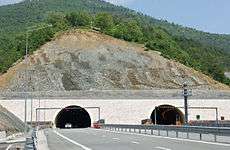
The highway passes through a 5.5 kilometres (3.4 mi)-long double-bore tunnel. Construction works on the tunnel began in May 2007 and were completed with one tunnel tube inaugurated in June 2009. The south-bound tunnel was completed in July 2010.
All four faces of the two tubes of the tunnel have been worked on simultaneously. Rrëshen - Kalimash segment's third section of road between Thirrë and Kolshi included Mt. Runes at an elevation of 1,858 metres (6,096 ft). Laying road on Mt. Runes proved to be a challenge for the engineers. Another challenge was the transportation of construction equipment and material. As about 3,800 people worked on the project, there was the additional responsibility of feeding, clothing and housing them. A partial collapse occurred at a 50 metres (160 ft) section in the central-south bore of the tunnel in November 2009. No injuries or equipment damages were reported. The collapse occurred because of heavy overbreak (during excavation) at a geologically complex area inside the tunnel and delayed the completion of the south-bound tunnel. During the tunnel construction, the tunneling team encountered five types of rock. In fact, only the north-bound tunnel was opened as per schedule in June 2009.
Tolling
.jpg)
Since 2018, A1 is operated by Albanian Highway Concession shpk. Toll booths were installed, and became operational in September 2018, east of the tunnel entrance at Kolsh, as part of making A1 the first toll motorway in Albania. Once the company took over the management of the motorway, significant improvements were made to the safety and design of the motorway. Such improvements include the construction of new interchanges, pedestrian overpasses, installing of fencing and electronic signage, expanding of viaducts, and the eventual construction of the new bridge over Drini River.
In March 2018, the motorway became a toll highway, but only temporarily. Such move was fiercely opposed by locals who claimed lack of consultation from the government and unaffordable fees. The protests turned violent and consequently made the government to withdraw from their position, and eventually consultations took place with the affected parties. After undergoing renovations, the toll plaza was finally re-opened in September 2018.
Funding and Contractors
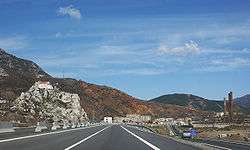
The highway project is the biggest road infrastructure project ever done in Albania. Its initial cost was estimated at €600m but during the course of construction this has more than doubled. The project was financed by the government of Albania and some foreign lending institutions. The total cost of the highway is estimated to be over €1bn ($1.4bn). amid allegations of corruption and a growing public debt.[12]
The contract for the construction of road segment between Rreshen and Kalimash, which constitutes one-third of the whole project, was awarded to a joint venture between Bechtel, a US-based engineering company, and Enka, a Turkey-based construction company. The contract was awarded in September 2006 and a majority of the construction works were completed by June 2009, even though construction on Milot-Rreshen started in 2003 by the government of Fatos Nano. Contractors working in the remaining portions of the highway were Albanian, Austrian, and Slovenian based firms. The R7 motorway in Kosovo was also constructed by Bechtel-Enka.
Exit list
.jpg)
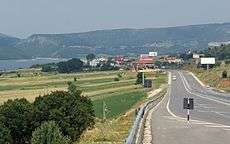
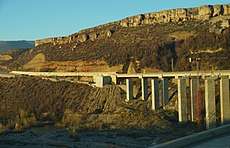
| km | Type | Name | Destination | Notes |
|---|---|---|---|---|
| 0.0 | Fushe-Milot | Milot Trumpet Interchange linking A1 with Lezhe and Shkoder to the north, Tirana to the south, and Pristina, Kosovo to the east | ||
| Milot | Connection to Lezhe in the north, and Lac in the south | |||
| Skuraj | Connection to Burrel, Peshkopi, and Ulëz Lake Regional Nature Park in Mat region | |||
| Rubik | Connection to Rubik, Katund i Vjeter area, and nearby Berzane Reserve in historic Mirdita region | |||
| Rreshen | Connection to Rreshen, Mirdita and Lura National Park to the south, and the old alternate Qafa Malit route to the north | |||
| Reps | Connection to old Qafa Malit route towards Puka and Fushe-Arrez | |||
| NBT Oil Rest Area | Accessible westbound only | |||
| Fan | Connection to Klos and Zall-Xhuxha, Fan area | |||
| Kastrati Rest Area | Accessible eastbound only | |||
| Thirrë-Kalimash Tunnel 5.6 km long | ||||
| 86.1 | Kalimash | Connection to Fushe-Arrez and Puka to the west, and Kolsh to the east | ||
| 90.9 | Mamez | Connection to Mamez | ||
| Drini Bridge | Drini Bridge to be upgraded to full motorway standard | |||
| Kukes | SH26 | Connection to Kukes and Shtiqen | ||
| Breglume | Former viaduct detour road | Connection to Breglume | ||
| 103.3 | Gjegjan | Connection to Gjegjan and Perbreg | ||
| Bardhoc | Connection to Bardhoc | |||
| Bardhoc I | Connection to Bardhoc i Ri | |||
| 113.5 | Morine | Connection to Morine | ||
| 114 | End of | |||
Impact
Since the end of the Kosovo War of 1999, hundreds of thousands of Albanians have passed through the old mountain road to get to Albania's beaches.[13] Building a highway would "crystallize a year-round tourism industry and double the size of the Albanian market", while allowing both communities to rationalize agriculture.[13] Travel times are expected to be lowered to two and a half hours or less, down from seven.[13]
Once finalized, the project will link the Adriatic Sea with the Pan-European corridor X at the E80 near the town of Merdar between the contested Kosovo-Serbia border.
US Congressman Eliot Engel has compared Sali Berisha's vision to build this highway to that of Eisenhower to build highways across the United States.[14]
See also
- Motorways in Albania
- Transport in Albania
- Adriatic Ionian Corridor
Notes
- Kosovo is the subject of a territorial dispute between the Republic of Kosovo and the Republic of Serbia. The Republic of Kosovo unilaterally declared independence on 17 February 2008, but Serbia continues to claim it as part of its own sovereign territory. The two governments began to normalise relations in 2013, as part of the 2013 Brussels Agreement. Kosovo is currently recognized as an independent state by 97 out of the 193 United Nations member states. In total, 112 UN member states recognized Kosovo at some point, of which 15 later withdrew their recognition.
References
- https://www.infrastruktura.gov.al/wp-content/uploads/2018/09/Monitoring-Report-of-Transport-strategy-and-Action-Plan-2016-2020.pdf
- "MILOT – MORINE HIGHWAY PROJECT" (PDF). businesshungary.gov.hu. 8 February 2016. Archived from Re-tender_V1_ENG.pdf the original Check
|url=value (help) (PDF) on 3 December 2017. - "RRUGA 6: AUTOSTRADA PRISHTINE - SHKUP" (PDF). riinvestinstitute.org (in Albanian). 2015. pp. 13–28.
- "Die Rruga Kombëtare Durrës-Kukës-Morina – die wirtschaftlichen und sozialen Auswirkungen nationaler Großprojekte auf lokaler Ebene" (PDF). oasa.berlin (in German). pp. 1–4.
- "THE CORE TRANSPORT NETWORK South-East Europe Transport Observatory SEETO" (PDF). ec.europa.eu. p. 2.
- https://www.iknshpk.al/en/independent-engineer-services-milot-morine-highway-concession-project
- "Albania Plans Tolls for Kosovo Highway". balkaninsight.com. Retrieved 30 May 2011.
- United Nations Economic Commission for Europe. "European Agreement on Main International Traffic Arteries" (PDF). unece.org. Retrieved 26 April 2011.
- Ministry of Infrastructure and Energy. "SECTORIAL STRATEGY OF TRANSPORT & ACTION PLAN 2016 – 2020" (PDF). infrastruktura.gov.al. Tirana. pp. 15–16.
- "The Adriatic - Ionian Transport Corridor" (PDF). researchgate.net. p. 5.
- "Brnabic: Construction of Nis-Pristina-Tirana-Durres motorway to begin in 2019". serbianmonitor.com.
- "Politics heat up as Basha's charges are brought to Supreme Court". tiranatimes.com.
- Benet Koleka (28 June 2007). "Highway set to bring Albania and Kosovo closer". Reuters. Retrieved 13 June 2009.
- "Engel: Berisha si Auzenhaur, nderton sistem autostradash ()". Koha Jone Magazine. 7 June 2010. Archived from the original on 21 September 2010.
External links
| Wikimedia Commons has media related to Autostradë A1 (Albania). |
- Albanian Highway Concession Official Facebook Page
- Bechtel Official Website
- Enka Official Website

